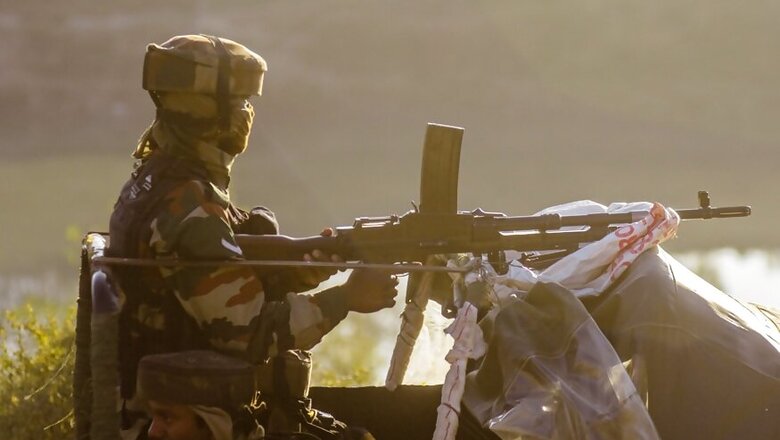
views
On February 9, 2001, a group of terrorists surrounded three dhoks (mud huts) at Kot Charwal in Rajouri district of Jammu region.
The dhoks were bolted from outside, set on fire, and grenades lobbed through a hole hammered through the roof. When the embers had cooled and the ash brushed aside, 15 bodies were found, seven of whom were children. All of them belonged to the Bakarwal community. The trigger for this massacre was the formation of the first all-Muslim Village Defence Committee (VDC) by the Gujjar-Bakarwal community in December 2000.
Militancy erupted in Kashmir in 1989, but it left the Jammu region relatively untouched for the first three years. The first major terrorist strike in Jammu occurred when 17 Hindus were pulled out of a bus and shot dead in Doda district in August 1993. When a series of bomb blasts rocked Jammu city in 1994 and 1995, it was obvious that the terrorists were specifically targeting the Hindu community.
By 1996, militancy had spread to the Muslim-dominated border districts of Poonch and Rajouri. These two districts have a high percentage of the Muslim Gujjar and Bakarwal community. In the initial euphoria for Azadi, the Gujjars and Bakarwals provided recruits and guides to the foreign terrorists who were infiltrating from Pakistan and had established a base in this area.
However, the extreme ideology of Pakistani terrorists did not resonate with the local culture. Fed up with excesses of the terrorists, which included the sexual exploitation and killing of Muslim girls on suspicion of being informers, the villagers of Kot Charwal formed the first all-Muslim VDC. Furious, the terrorists attacked Kot Charwal.
After this massacre, more Gujjars and Bakarwals entered the fight against terrorists. In 2002, Tahir Fazal Choudhary of Marrah village, along with a number of Gujjars working in Saudi Arabia, decided to return to their homes. They had received letters from their families complaining about the brutality and harassment by Pakistani terrorists who had established their dominance in the higher reaches of Pir Panjal. It was in this area, commonly known as Hill Kaka, that the Army launched one of the biggest operations in 2003 — Operation Sarp Vinash.
The success of Operation Sarp Vinash was in no small measure due to the support of people like Tahir Fazal and other residents of the twin villages of Marrah-Kulali who provided intelligence to the Army and fought by their side. They also paid a heavy price for this support.
One year later, terrorists sneaked into Teli Katha village in the upper pastures of Hill Kaka and opened fire on the sleeping Gujjar families as retribution against the locals who had participated in Operation Sarp Vinash. There were 12 deaths, including five children. The toll would have been higher if some of the VDC members who were present had not resisted and fired back.
In his article, Ethnic Defection in Civil War, Stathis N. Kalvas defines ethnic defection as “a process whereby individuals join organisations explicitly opposed to the national aspirations of the ethnic group with which they identify and end up fighting against their coethnics.”
He goes on to say that “the process of ethnic defection is extremely consequential even when the numbers of defectors remain relatively small. This is so, because ethnic identity ceases to be a reliable indicator of pro-ethnic rebel behaviour. Accordingly, ethnic rebels are forced to resort to violence against members of their own ethnic group, so as to deter further defection. The resulting intraethnic violence undermines the ethnic rebels’ claim that they represent the true will of the entire group. In short, ethnic defection matters, because it destroys precisely those elements that make ethnic identity so important for collective action in the first place.”
Once the Gujjar and Bakarwal communities had turned against the terrorists, it was only a matter of time before the lack of local support became a severely limiting factor in the ability of terrorists to survive south of Pir Panjal.
Thereafter, the security forces killed and drove out the terrorists from Jammu region. The 2014 'Crime Gazette' of the Jammu and Kashmir police stated that there was not a single active militant in the Jammu, Udhampur, Reasi, Poonch, Doda and Samba districts.
It is true that there have been many significant contributions by the Army, police and local civil society groups in turning back the arc of terrorism from Jammu. It is also true that in the initial years, the Gujjars and Bakarwals provided substantial support to the terrorists, and that there is still some suspicion about Bakarwals working as guides along the Line of Control.
However, a key importance of their contribution lies in the fact that it demolished the narrative that the Muslim community was being so badly suppressed in Jammu and Kashmir that it would rise up as one against the Indian state and support terrorists coming from Pakistan.
In the current age of the new media, it is only today's headline that has any meaning. And the social media, with us as its warriors, can amplify this headline to take on a life of its own. Post-truth is the new reality and in this daily media assault, the past is almost forgotten.
This piece is a small attempt to remember history.
(The author is former Northern Commander, Indian Army, under whose leadership India carried out surgical strikes against Pakistan in 2016. Views are personal.)


















Comments
0 comment